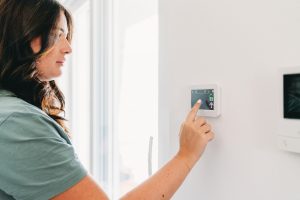When your air conditioning system isn’t working as expected, your first thought might be that the AC unit itself is to blame. However, the real culprit could be something much simpler—your thermostat. Determining whether the problem lies with your AC or your thermostat is crucial for resolving the issue quickly and efficiently.
In this post, we’ll explore common HVAC problems that could originate from either your thermostat or your air conditioner and explain how a professional technician can diagnose it and provide AC repair in Pueblo, CO.
1. Inconsistent Temperatures
One of the most common signs of a problem is inconsistent temperatures throughout your home. If some rooms are too cold while others are too warm, your first instinct might be to blame your AC. However, this issue could also stem from a malfunctioning thermostat. If your thermostat is inaccurately reading the indoor temperature, it might be sending the wrong signals to your AC, causing it to overcool or undercool certain areas. A technician can recalibrate or replace the thermostat to ensure it’s functioning correctly and providing accurate temperature readings.
2. AC Won’t Turn On
When your air conditioner refuses to turn on, it’s easy to assume the unit is broken. However, the problem might actually be with the thermostat. If the thermostat’s batteries are dead, or if the device has a wiring issue, it won’t send the signal to your AC to start up. Before calling a technician, try replacing the batteries in your thermostat and check the settings to make sure it’s set to the correct mode. If these steps don’t resolve the issue, it’s time to call in a professional to inspect both the thermostat and the AC unit to pinpoint the source of the problem.
3. Short Cycling
Short cycling, where your AC frequently turns on and off without completing a full cooling cycle, can be a frustrating problem. While this issue is often related to the AC unit itself, such as an oversized system or refrigerant leaks, it can also be caused by a faulty thermostat. If the thermostat is placed in a location where it gets hit by direct sunlight or is near a heat source, it might think the room is warmer than it actually is, causing the AC to short cycle. A technician can move the thermostat to a better location or suggest a more advanced thermostat model to resolve the issue.
4. Inaccurate Temperature Readings
If you set your thermostat to a specific temperature but your home feels noticeably warmer or cooler, the thermostat could be the issue. An inaccurate temperature reading can lead to inefficient cooling and higher energy bills. A professional technician can test the thermostat’s accuracy and recalibrate it if necessary. If the thermostat is outdated or malfunctioning, the technician may recommend replacing it with a more reliable, programmable, or smart thermostat, which can also offer additional energy-saving features.
5. Unresponsive Controls
When you try to adjust your thermostat but nothing happens, it’s likely a sign that the device is malfunctioning. Unresponsive controls could be due to an internal fault, wiring issues, or a problem with the thermostat’s connection to the HVAC system. While it might seem like a minor inconvenience, an unresponsive thermostat can prevent your AC from operating correctly, leading to discomfort in your home. A professional can inspect the wiring and connections to determine if the thermostat needs to be repaired or replaced.
For accurate diagnosis, schedule an appointment with SoCo Heating and Cooling. So Cool. So Cozy.

